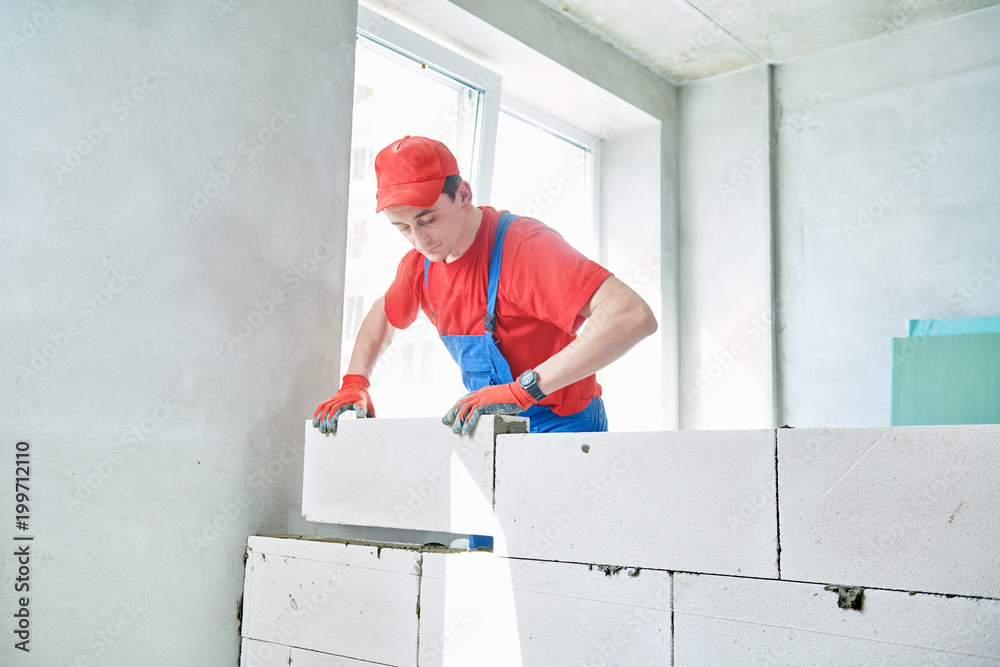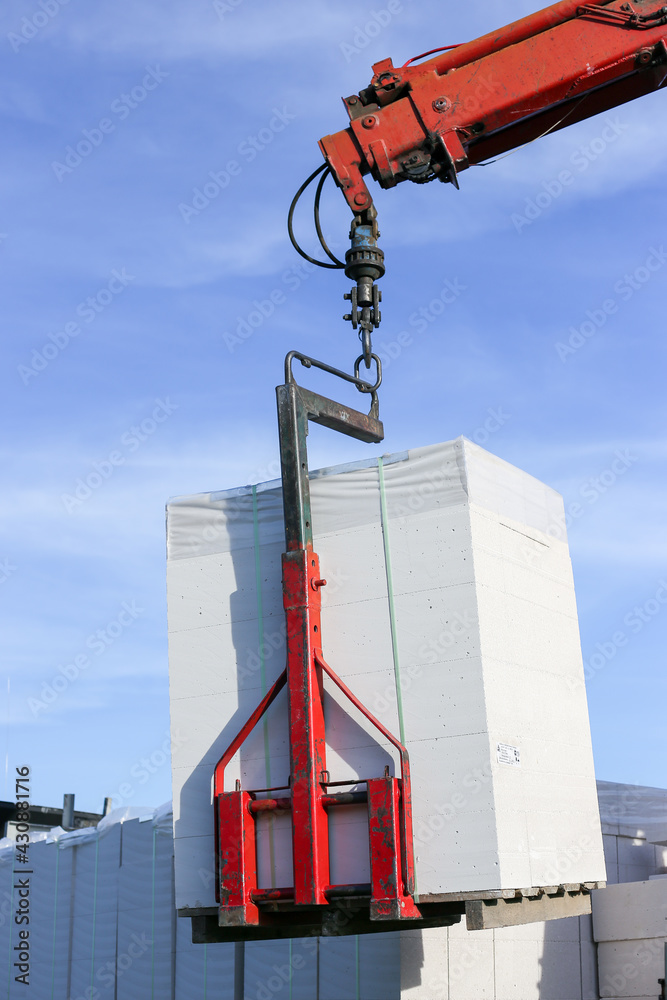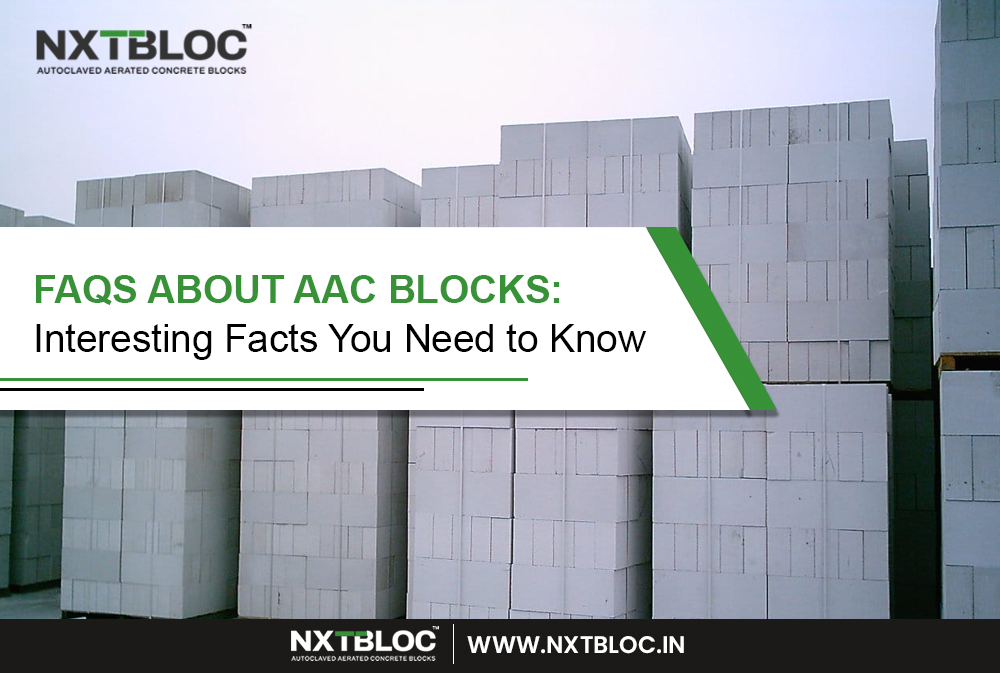At NXTBLOC, we’re passionate about innovation in construction. That’s why we champion AAC blocks (Autoclaved Aerated Concrete) – a revolutionary building material that offers a perfect blend of strength, efficiency, and sustainability.
Table of Contents
We understand that you might have questions about AAC blocks before incorporating them into your next project. So, we’ve compiled comprehensive FAQs about AAC blocks to address everything you need to know!
What are AAC blocks?
AAC blocks are lightweight, precast building materials made from a unique combination of sand, cement, lime, water, and a small amount of aluminium powder. This aluminium powder reacts with the other elements during the manufacturing process, creating tiny air pockets throughout the block. These air pockets are what give AAC blocks their impressive lightweight properties while maintaining structural integrity.

FAQs about AAC blocks benefits?
There are numerous advantages to choosing AAC blocks for your construction project. Here are some of the key benefits:
- Lightweight: As mentioned earlier, AAC blocks are significantly lighter than traditional bricks or concrete. This translates to several advantages:
- Reduced dead load on the structure: Lighter walls require less robust foundations, leading to cost savings.
- Easier transportation and handling: AAC blocks are easier to transport and manoeuvre on-site, reducing labour costs.
- Feasibility for multi-story buildings: The lighter weight makes AAC blocks ideal for constructing higher floors without compromising structural integrity.
- Superior insulation: The air pockets within AAC blocks act as natural thermal insulators. This translates to cooler interiors in summer and warmer interiors in winter, significantly reducing your energy consumption for heating and cooling.
- Fire resistance: AAC blocks are inherently fire-resistant, offering excellent fire protection. They can withstand high temperatures for extended durations, providing valuable time for occupants to evacuate safely.
- Soundproofing: The cellular structure of AAC blocks also contributes to superior soundproofing qualities. This makes them ideal for residential construction in noisy environments or for creating soundproof partitions within buildings.
- Workability: AAC blocks are easy to cut, drill, and shape using standard carpentry tools. This allows for greater design flexibility and simplifies the construction process.
- Sustainability: AAC block production requires less energy compared to traditional brick or concrete manufacturing. Additionally, the lightweight nature of AAC blocks reduces transportation emissions.
- Faster construction: The larger size of AAC blocks compared to bricks allows for faster wall construction, leading to shorter project timelines.
- Cost-effective: While the initial cost per AAC block might be slightly higher than traditional bricks, the overall construction savings due to reduced labour, lighter foundations, and faster construction often make AAC blocks a more cost-effective option in the long run.
FAQs about AAC blocks disadvantages?
While AAC blocks offer a multitude of benefits, it’s important to consider some potential drawbacks:
- Susceptibility to moisture: AAC blocks are more susceptible to moisture damage compared to traditional bricks. Therefore, proper waterproofing measures are crucial for exterior walls and foundations.
- Lower load-bearing capacity: While AAC blocks offer good structural strength, their load-bearing capacity is generally lower than traditional concrete. For high-rise buildings or projects requiring very high load-bearing walls, AAC blocks might not be suitable.

What applications are AAC blocks suited for?
AAC blocks are a versatile building material with a wide range of applications, including:
- Residential construction: AAC blocks are ideal for building houses, apartments, and villas due to their ease of use, thermal insulation properties, and fire resistance.
- Commercial construction: AAC blocks can be used for constructing office buildings, retail spaces, and hotels due to their fast construction capabilities, soundproofing qualities, and fire safety.
- Industrial construction: AAC blocks can be used for building warehouses, factories, and other industrial structures due to their dimensional accuracy and ease of modification.
- Cladding and partitions: AAC blocks are perfect for creating non-load-bearing walls, partitions, and claddings due to their lightweight nature and ease of workability.
What are some common myths about AAC blocks?
There are several misconceptions surrounding AAC blocks. Here, at NXTBLOC, we want to set the record straight about common FAQs about AAC blocks myths:
Myth 1: Due to Their Lightweight Architecture, AAC Blocks Are Not strong.
- Fact: AAC blocks are engineered to be lightweight without sacrificing strength. The autoclaving process they undergo during manufacturing imparts exceptional compressive strength, making them suitable for load-bearing applications.
Myth 2: AAC Blocks Lack Durability Compared to Traditional Bricks.
- Fact: AAC blocks are highly durable and can withstand harsh weather conditions. They are resistant to cracking, shrinking, and insect infestation.
Myth 3: AAC Blocks Are Expensive.
- Fact: While the initial cost per block might be slightly higher, the overall construction savings
Using AAC Blocks in Your Project: What You Need to Know

Choosing the Right AAC Block for Your Needs
NXTBLOC offers a variety of AAC block sizes and densities to cater to different construction needs. Here’s a breakdown of some key factors to consider when choosing AAC blocks:
- Block Size: AAC blocks come in various sizes, with larger blocks allowing for faster construction. However, smaller blocks might be more suitable for intricate designs or tight spaces.
- Block Density: The density of an AAC block refers to its weight per cubic meter. Higher-density blocks offer greater structural strength but are heavier. Lower-density blocks are lighter and offer superior insulation but have a slightly lower load-bearing capacity.
Here’s a general guide to choosing AAC blocks based on density:
- Low Density (D400): Ideal for non-load-bearing walls, partitions, and claddings where thermal insulation is a priority.
- Medium Density (D500): A good balance between strength and insulation. Suitable for most load-bearing walls in low-rise residential construction.
- High Density (D600): Offers superior structural strength for load-bearing walls in multi-story buildings or projects with high weight requirements.
It’s always recommended to consult with a structural engineer to determine the most suitable AAC block type and size for your specific project requirements.
Construction Considerations with AAC Blocks
While AAC blocks offer a streamlined construction process, here are some essential points to remember:
- Proper Handling: AAC blocks are lightweight but delicate. Ensure careful handling during transportation and on-site to prevent damage.
- Cutting and Shaping: AAC blocks can be easily cut and shaped using standard carpentry tools. However, it’s crucial to use proper personal protective equipment (PPE) to prevent dust inhalation.
- Mortar and Adhesives: AAC blocks require thin-set mortar or specialized AAC block adhesives for proper bonding. Using regular mortar can compromise the thermal insulation properties of the blocks.
- Waterproofing: As mentioned earlier, AAC blocks are susceptible to moisture damage. Therefore, proper waterproofing measures are essential for foundations, basements, and exterior walls. This may involve applying a water-resistant membrane or using a specific type of AAC block with enhanced moisture resistance.

Benefits of Choosing NXTBLOC for Your AAC Block Needs
At NXTBLOC, we are committed to providing the highest quality AAC blocks for your construction project. Here’s why you should choose NXTBLOC:
- Unmatched Quality: We utilize top-grade raw materials and employ stringent quality control measures to ensure our AAC blocks meet the highest standards for strength, durability, and dimensional accuracy.
- Diverse Product Range: We offer a wide variety of AAC block sizes and densities to cater to the specific requirements of your project.
- Technical Expertise: Our team of experienced professionals is here to assist you in choosing the right AAC blocks and provide technical guidance throughout the construction process.
- Sustainability Focus: We prioritize sustainable practices throughout the manufacturing process, minimizing our environmental impact.
We are confident that NXTBLOC AAC blocks can revolutionize your construction project, offering superior performance, faster construction times, and significant cost savings.
For further information or FAQs about AAC blocks, including product specifications, and technical details, or to connect with our team, please visit our website or contact us on social media channels.
